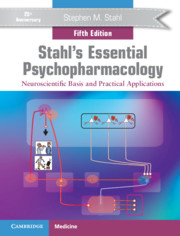Book contents
- Stahl’s Essential Psychopharmacology
- Additional material
- Stahl’s Essential Psychopharmacology
- Copyright page
- Contents
- Preface to the Fifth Edition
- CME Information
- 1 Chemical Neurotransmission
- 2 Transporters, Receptors, and Enzymes as Targets of Psychopharmacological Drug Action
- 3 Ion Channels as Targets of Psychopharmacological Drug Action
- 4 Psychosis, Schizophrenia, and the Neurotransmitter Networks Dopamine, Serotonin, and Glutamate
- 5 Targeting Dopamine and Serotonin Receptors for Psychosis, Mood, and Beyond: So-Called “Antipsychotics”
- 6 Mood Disorders and the Neurotransmitter Networks Norepinephrine and γ-Aminobutyric Acid (GABA)
- 7 Treatments for Mood Disorders: So-Called “Antidepressants” and “Mood Stabilizers”
- 8 Anxiety, Trauma, and Treatment
- 9 Chronic Pain and Its Treatment
- 10 Disorders of Sleep and Wakefulness and Their Treatment: Neurotransmitter Networks for Histamine and Orexin
- 11 Attention Deficit Hyperactivity Disorder and Its Treatment
- 12 Dementia: Causes, Symptomatic Treatments, and the Neurotransmitter Network Acetylcholine
- 13 Impulsivity, Compulsivity, and Addiction
- Suggested Reading and Selected References
- Index
11 - Attention Deficit Hyperactivity Disorder and Its Treatment
Published online by Cambridge University Press: 19 October 2021
- Stahl’s Essential Psychopharmacology
- Additional material
- Stahl’s Essential Psychopharmacology
- Copyright page
- Contents
- Preface to the Fifth Edition
- CME Information
- 1 Chemical Neurotransmission
- 2 Transporters, Receptors, and Enzymes as Targets of Psychopharmacological Drug Action
- 3 Ion Channels as Targets of Psychopharmacological Drug Action
- 4 Psychosis, Schizophrenia, and the Neurotransmitter Networks Dopamine, Serotonin, and Glutamate
- 5 Targeting Dopamine and Serotonin Receptors for Psychosis, Mood, and Beyond: So-Called “Antipsychotics”
- 6 Mood Disorders and the Neurotransmitter Networks Norepinephrine and γ-Aminobutyric Acid (GABA)
- 7 Treatments for Mood Disorders: So-Called “Antidepressants” and “Mood Stabilizers”
- 8 Anxiety, Trauma, and Treatment
- 9 Chronic Pain and Its Treatment
- 10 Disorders of Sleep and Wakefulness and Their Treatment: Neurotransmitter Networks for Histamine and Orexin
- 11 Attention Deficit Hyperactivity Disorder and Its Treatment
- 12 Dementia: Causes, Symptomatic Treatments, and the Neurotransmitter Network Acetylcholine
- 13 Impulsivity, Compulsivity, and Addiction
- Suggested Reading and Selected References
- Index
Summary
Attention deficit hyperactivity disorder (ADHD) is not just a disorder of “attention,” nor does it have to include “hyperactivity.” Paradigm shifts are altering the landscape for treatment options across the full range of ADHD symptoms, from inattention to impulsivity to hyperactivity, as well as across all the waking hours and across the whole lifespan, from young children through adulthood. This chapter will provide an overview of the psychopharmacology of ADHD, including only short discussions of the symptoms of ADHD. The mechanism of action of treatments classically called stimulants and nonstimulants for ADHD will be emphasized. Information on the full clinical descriptions and formal criteria for how to diagnose and rate ADHD and its symptoms should be obtained by consulting standard reference sources. The discussion here will emphasize the links between various brain circuits and their neurotransmitters with the various symptoms and comorbidities of ADHD and how these are linked to effective psychopharmacological treatments. The goal of this chapter is to acquaint the reader with ideas about the clinical and biological aspects of attention, impulsivity, and hyperactivity. For details of doses, side effects, drug interactions, and other issues relevant to the prescribing of drugs for ADHD in clinical practice, the reader should consult standard drug handbooks (such as Stahl’s Essential Psychopharmacology: the Prescriber’s Guide).
- Type
- Chapter
- Information
- Stahl's Essential PsychopharmacologyNeuroscientific Basis and Practical Applications, pp. 449 - 485Publisher: Cambridge University PressPrint publication year: 2021
- 1
- Cited by



